- Best paper presentation award in the PRISM conference December 9, 2021
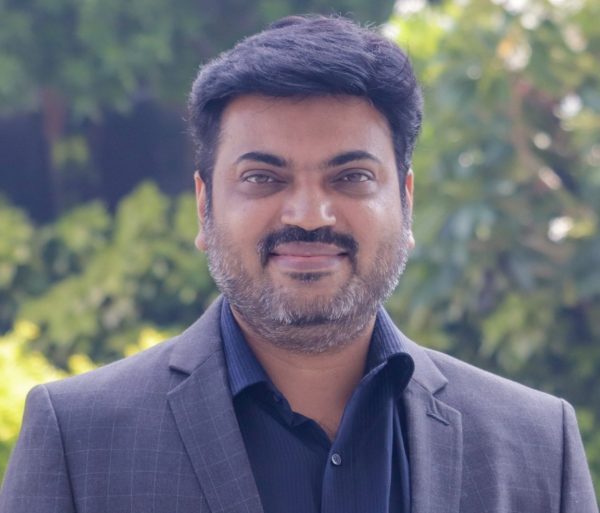 Research at SRM University-AP is always geared to top the solutions that we have to our current problems. One of the most enduring issues in the field of management is crisis management. The PRISM conference has found one of our faculty member’s solution to be most beneficial and awarded him with the Best Paper Presentation Award. Dr Vimal Babu, Associate Professor-SEAMS, has come up with a response that will not only help leaders manage crisis situations with increasing efficiency but also make it possible for them to thrive in the face of adversities.
Research at SRM University-AP is always geared to top the solutions that we have to our current problems. One of the most enduring issues in the field of management is crisis management. The PRISM conference has found one of our faculty member’s solution to be most beneficial and awarded him with the Best Paper Presentation Award. Dr Vimal Babu, Associate Professor-SEAMS, has come up with a response that will not only help leaders manage crisis situations with increasing efficiency but also make it possible for them to thrive in the face of adversities.About the paper:
The purpose of the present research is to understand how global pandemic forces shaped the leadership communication strategies of the managers working in the Information Technology (IT) industry in India, in turn, how their leadership communication strategies aided in achieving agile and authentic leadership communication in relation to their own employees. It studied the leadership communication strategies of managers which facilitated them to establish emotional connect with the employees working remotely during pandemic crisis.
Abstract:
An investigation of the major themes in leadership communication strategies during times of crisis is presented in this research. It applies thematic analysis (TA) as a qualitative method to investigate effective leadership communication strategies in crises to overcome employee-centric organisational issues. Major themes and sub-themes are linked together to grasp better understanding about qualitative data. As a result, a total of five major themes emerged. Findings reveal that HR managers must consider the impact on their employees’ well-being when making verbal communication and crafting messages for their teams during times of crisis. The research developed a conceptual framework for mapping out the major themes, viz. information consumption and news making; disinformation and narrative disruption; agile communication structures; striking the balance b/w humane and factual communication and leadership communication imperatives. The themes generated substantive theory featuring agile and authentic leadership communication for the managers. As organisational leaders, managers’ challenges and communication strategies during a crisis are discussed. Future research ideas are highlighted.
Social Implications:
As a result of this research, it is now possible to deal with crisis communication challenges of managers more effectively. To avoid reacting to disinformation, one must be able to recognise it when it appears in abundance in a short period of time and recognise it when it does not. Managers of the HR department are held in high regard by their employees, who look to them for guidance and support. An agile communication structure, such as clearly stated goals, lean approvals and clarity of purpose will have a big impact upon the designing of communication strategies initiated by organisational leaders, especially when the attempts are made to interact with the employees remotely. That being said, managers need to strike a balance between human and factual communication in order to develop trust, transparency, and cooperation with their employees.
Collaborators:
The present work has been successfully carried out with the contributions of the co-researchers of the research paper, viz. Dr. Anugamini Priya Srivastava, Symbiosis International University, Pune and Mr. Vipin Kumar, Project Management Professional, BT India.
Future:
The future research plans entail working in the area of employee sustainability, well-being and career development of the workforce along with crisis management.
Continue reading → - Dr Nimai Mishra on Impact of shell thickness on photostability studies of green-emitting “Giant” quantum dots December 8, 2021
 SRM University-AP is pleased to announce that Dr Nimai Mishra, Assistant Professor, Department of Chemistry, SRM University-AP, Andhra Pradesh, along with his research group comprising of students pursuing PhD under him, Mr Rahul Singh, Mr Syed Akhil, and Ms V.G.Vasavi Dutt, has published a research article titled “Shell thickness-dependent photostability studies of green-emitting “Giant” quantum dots” in the journal Nanoscale Advances (The Royal Society of Chemistry) with an impact factor of ~4.533.
SRM University-AP is pleased to announce that Dr Nimai Mishra, Assistant Professor, Department of Chemistry, SRM University-AP, Andhra Pradesh, along with his research group comprising of students pursuing PhD under him, Mr Rahul Singh, Mr Syed Akhil, and Ms V.G.Vasavi Dutt, has published a research article titled “Shell thickness-dependent photostability studies of green-emitting “Giant” quantum dots” in the journal Nanoscale Advances (The Royal Society of Chemistry) with an impact factor of ~4.533.About the research:
Highly efficient green-emitting core/shell giant quantum dots have been synthesized through a facile “one-pot” gradient alloy approach. Furthermore, an additional ZnS shell was grown using the “Successive Ionic Layer Adsorption and Reaction” (SILAR) method. Due to the faster reactivity of Cd and Se compared to an analogue of Zn and S precursors it is presumed that CdSe nuclei are initially formed as core and gradient alloy shells simultaneously encapsulate the core in an energy-gradient manner and eventually thick ZnS shells were formed. Using this gradient alloy approach, we have synthesized four different sized green-emitting giant core-shell quantum dots to study their shell thickness-dependent photostability under continuous UV irradiation, and temperature-dependent PL properties of nanocrystals. There was a minimum effect of the UV light exposure on the photostability after a certain thickness of the shell. The QDs diameter of ≥ 8.5 nm shows substantial improvement in photostability compared to QDs with a diameter ≤ 7.12 nm when continuously irradiated under the strong UV light (8 W/cm2, 365 nm) for 48 h. The effect of temperature on the photoluminescence intensities was studied with respect to shell thickness. There were no apparent changes in PL intensities observed for the QDs ≥ 8.5 nm, on the contrary, for example, QDs with < 8.5 nm in diameter (for ~7.12 nm) show a decrease in PL intensity at higher temperatures ̴90°C.
More importantly, these results highlight the synthesized green-emitting gradient alloy QDs with superior optical properties can be used for highly efficient green emitters and are potentially applicable for the fabrication of green LEDs.
Read the full paper: https://pubs.rsc.org/en/content/articlelanding/2021/NA/D1NA00663K
Continue reading → - On Applications of Machine Learning Methods in Physics December 8, 2021
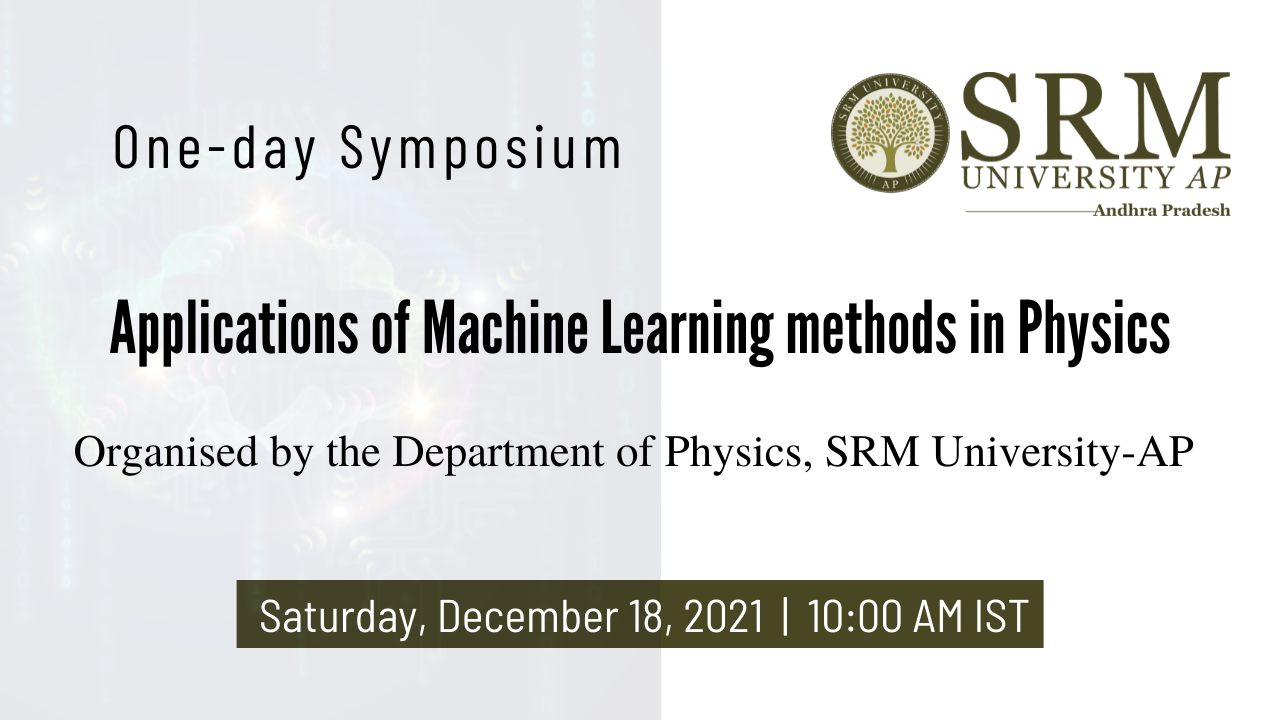
The Department of Physics at SRM University-AP is organising a one-day symposium with national and international academicians on the theme Applications of Machine Learning Methods in Physics. The programme which will begin at 10.00 am on December 18, 2021, will deeply look into two domains of research, namely Particle Physics and Statistical Physics. Eminent experts from computer science and physics domains will deliver talks for a wider audience, especially for students of basic sciences and engineering streams. The event is going to be entirely through Online mode. Dr Amit Chakraborty and Dr Soumyajyoti Biswas from the Department of Physics, SRM University-AP are the conveners of the symposium.
Programme Schedule of the Invited Lectures:
Time: 10.05 – 11.05 AM (IST)
Speaker: Prof Vineeth N Balasubramanian (IIT Hyderabad)
Title: Explainable Deep Learning: Overview, Trends and ChallengesAbstract: The last decade has seen rapid strides in Artificial Intelligence (AI) moving from being a fantasy to a reality that is a part of each one of our lives, embedded in various technologies. A catalyst of this rapid uptake has been the enormous success of deep learning methods for addressing problems in various domains including computer vision, natural language processing, and speech understanding. However, as AI makes its way into risk-sensitive and safety-critical applications such as healthcare, aerospace and finance, it is essential for AI models to not only make predictions but also be able to explain their predictions. This talk will introduce the audience to this increasingly important area of explainable AI, describe salient methods in explainable deep learning, discuss open challenges as well as present some of our recent research in this domain.
Time: 11.30 AM – 12.30 PM (IST)
Speaker: Dr Girish Varma (IIIT Hyderabad)
Title: Deep Generative Methods and ApplicationsAbstract: Generative methods deals with the modelling of complex high dimensional probability distributions. With the advent of deep neural networks, these methods have become more common with the discovery of new techniques like GANs. Such methods can learn to generate images, graphs etc even without using labelled data. In this talk, we will give some of the common deep generative modelling techniques like GANs, Variational Autoencoders, Normalizing Flows. We will also look at some example applications in Style Transfer, Super Resolution in Computer Vision, Conditional Generation of Molecules in Physics etc.
Time: 2.00 – 3.00 PM (IST)
Speaker: Dr Sanmay Ganguly (University of Tokyo, Japan)
Title: The Deep Relation Between Particle Physics and Machine LearningAbstract: At the CERN Large Hadron Collider (LHC) experiment, trillions of protons get smashed with each other at very high energies every second. Remnants of this collision are collected and studied to infer what fundamental interactions are happening at the core. Analysing and extracting meaningful physics information out of this large data is a highly challenging statistical analysis, part of which has to be carried out in real-time. Modern deep learning techniques have brought a change in paradigm in the whole field, where it is observed that the application of ML truly impacts at all corners. In this presentation the speaker will try to give a general overview of the ongoing ML activities, mainly highlighting the areas in the context of LHC physics and shortly touch other branches of HEP.
Time: 3.30 – 4.30 PM (IST)
Speaker: Prof Lasse Laurson (Tampere University, Finland)
Title: Machine Learning Plastic Deformation of CrystalsAbstract: The speaker will present an overview of our recent efforts to apply machine learning to predict the fluctuating plastic deformation process of small crystals, mediated by the stress-driven motion of dislocations. To this end, we use machine learning to establish mappings between the initial state of a sample and the corresponding stress-strain curve, considering different loading protocols and geometries of the dislocation assembly. He will start with a discussion of machine learning the depinning process of edge dislocation pileups, after which he will consider the problem of machine learning-based prediction of the stress-strain response of two- dimensional systems of discrete dislocations subject to stress-controlled and strain-controlled loading.
Register soon and claim your seats at this one-day international online symposium organised by the Department of Physics, SRM University-AP!!
Continue reading → - Distinguished Lecture Series with Prof Ratnasingham Shivaji December 6, 2021
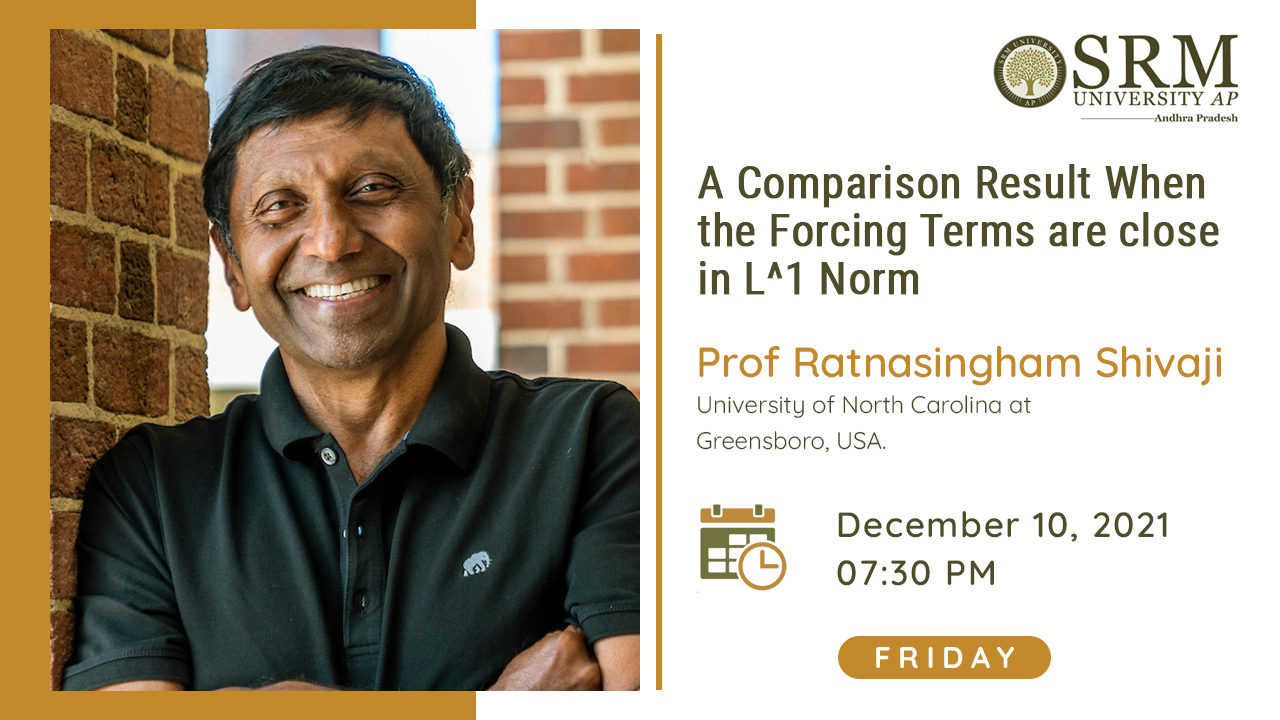 The Department of Mathematics is bringing to you the next thrilling edition of the Distinguished Lecture Series with Prof Ratnasingham Shivaji. Prof Shivaji will take the spotlight on December 10, 2021, at 7.30 pm IST and enlighten us about “A Comparison Result When the Forcing Terms are close in L^1 Norm.”
The Department of Mathematics is bringing to you the next thrilling edition of the Distinguished Lecture Series with Prof Ratnasingham Shivaji. Prof Shivaji will take the spotlight on December 10, 2021, at 7.30 pm IST and enlighten us about “A Comparison Result When the Forcing Terms are close in L^1 Norm.”About the speaker:
Prof. Ratnasingham Shivaji received his PhD in Mathematics from Heriot-Watt University in Edinburgh, Scotland in 1981 and his B.S (first-class honours) from the University of Sri Lanka in 1977. He joined the University of North Carolina at Greensboro (UNCG) on July 1, 2011, as Head of the Department of Mathematics and Statistics and served in this position until July 31, 2019. Beginning in January of 2012, he was named H. Barton Excellence Professor. Prior to joining UNCG, he served for twenty-six years at Mississippi State University (MSU), where he was honoured as a W.L. Giles Distinguished Professor. In 2019, he was also named a Fellow of the American Mathematical Society. He is the recipient of the 2020 Mathematical Association of America (MAA) Southeastern Section Award for Distinguished University Teaching of Mathematics.
Prof. Shivaji’s area of specialization is partial differential equations, particularly in nonlinear elliptic boundary value problems. His research work has applications in combustion theory, chemical reactor theory, and population dynamics, and has been funded by the National Science Foundation and the Simon’s Foundation. Currently, he is serving as the PI on an NSF Math Ecology grant. He has authored one hundred and sixty research papers. He is a member of the Editorial Board of several mathematics journals.
Abstract:

This session would provide a unique opportunity to interact with such a distinguished personality in the field of mathematics. Please make the most of this exciting opportunity on December 10, 2021, at 7.30 pm IST.
Continue reading → - SRM University-AP celebrates its 1st convocation December 4, 2021
Hans India – Dec 02
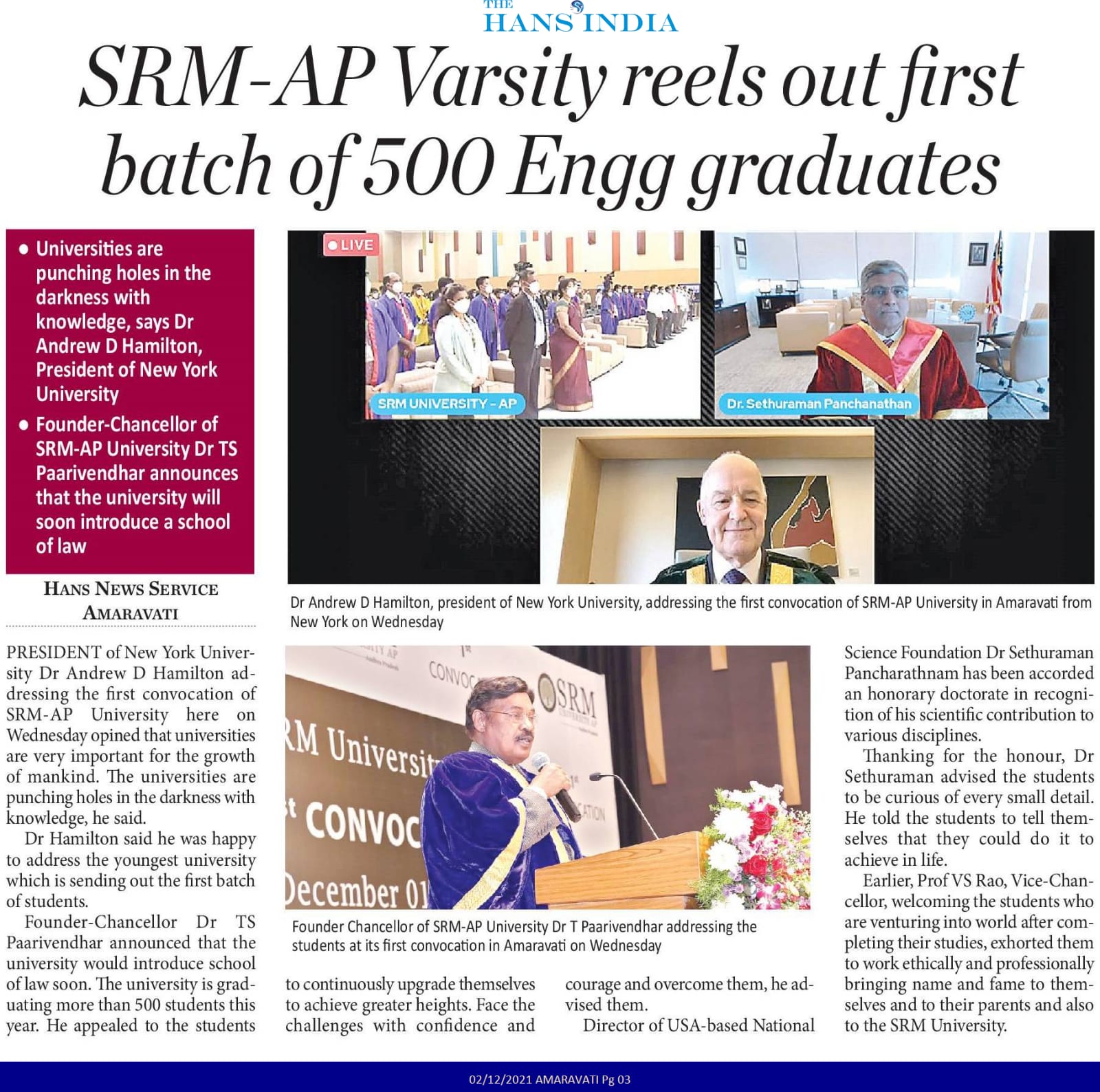
News Careers360 – Dec 02

ANI News – Dec 02

Ndtv – Dec 02
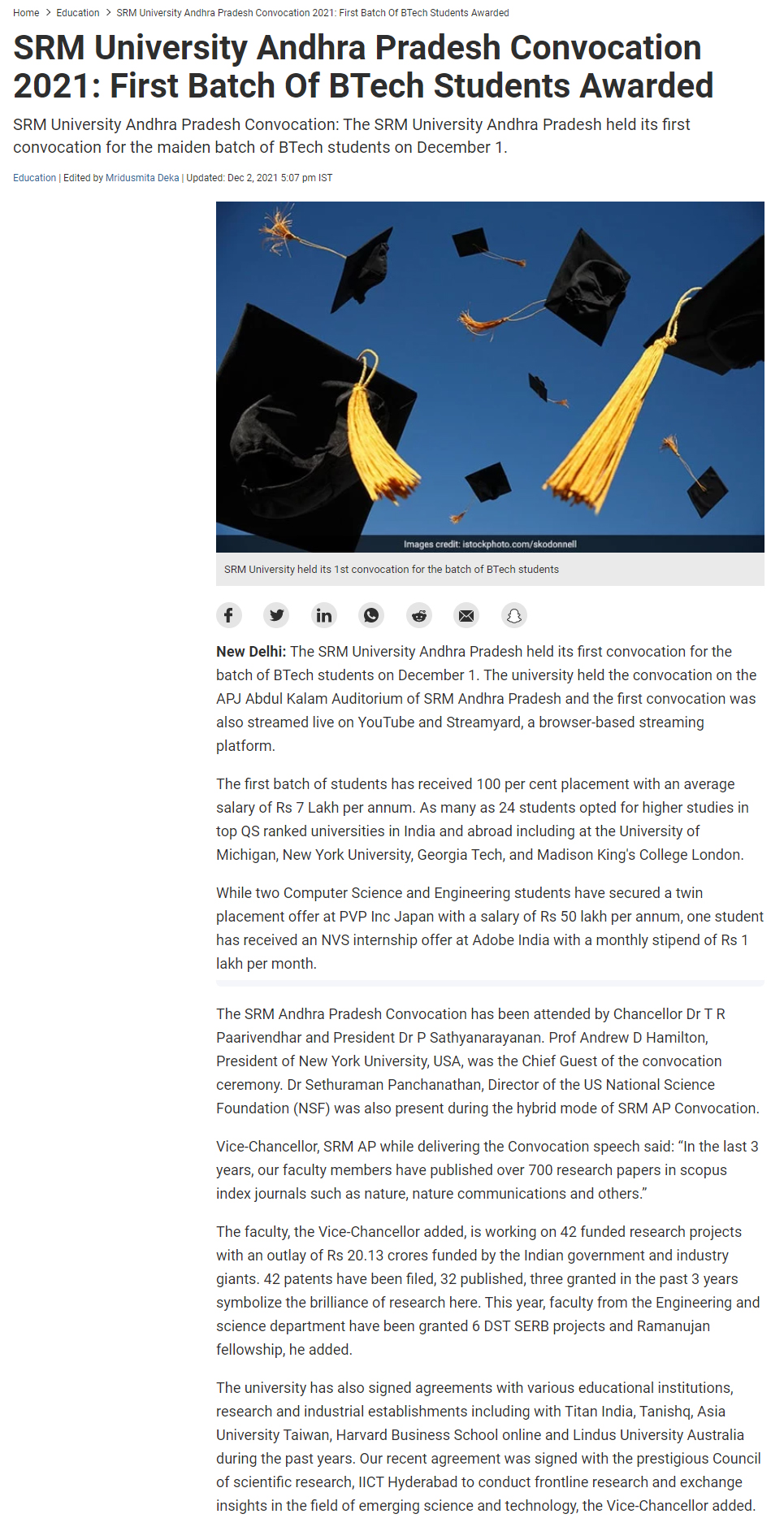
Eenadu – Dec 02
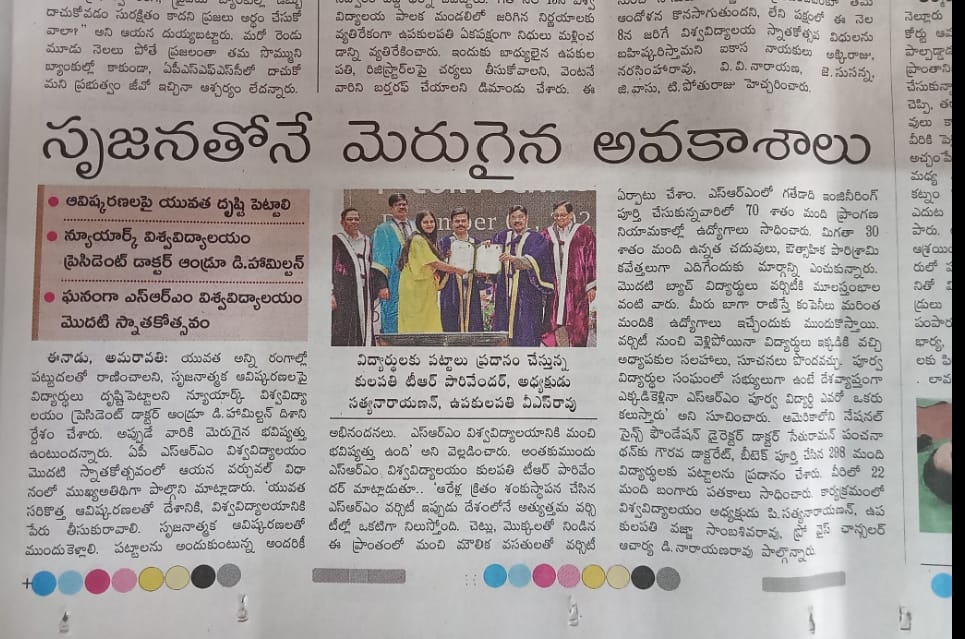
Manam – Dec 02

Surya – Dec 02
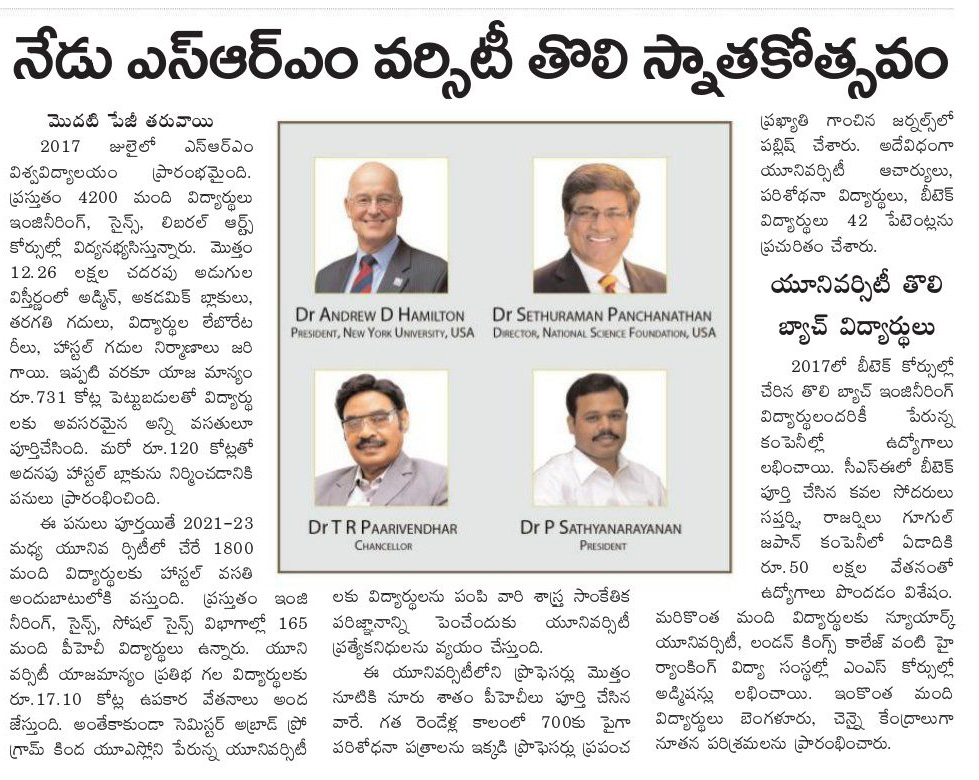
Vartha – Dec 02

Visalandhra – Dec 02
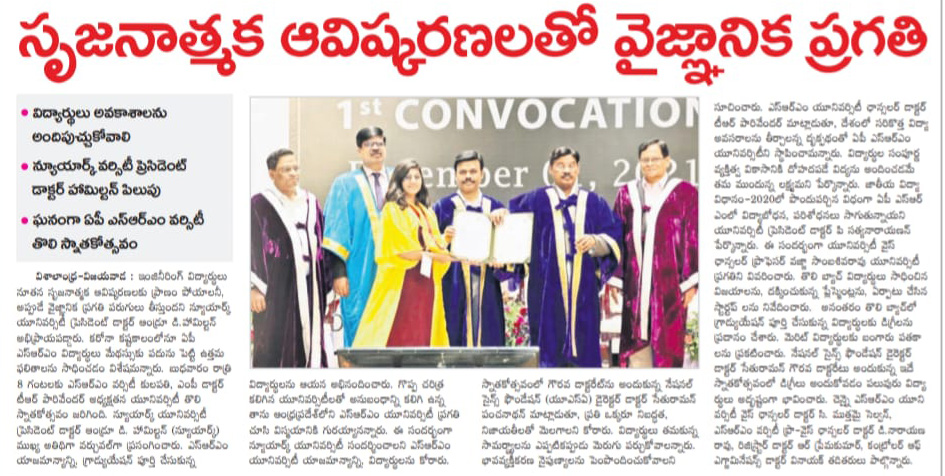
Sakshi – Dec 02
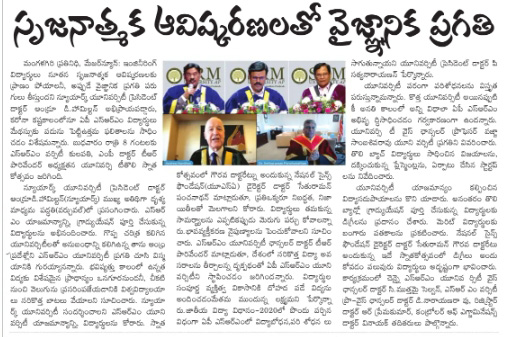
Andhra Prabha – Dec 02
Continue reading →


